Words that tell more about a picture
caption
Which of these describes a character's trait?
- a) Where the story takes place
- b) How the character feels or acts
- c) The problem in the story
- d) The ending of the story
b) How the character feels or acts
What is "your own point of view"?
- a) The author's feelings.
- b) What you think or believe about something.
- c) The setting of the story.
- d) The glossary in the back of the book.
b) What you think or believe about something.
What action did the mouse take to free the captured lion?"
gnawed or chewed through the ropes.
1. The dog _________ loudly at the mail carrier.
a) bark b) barking c) barked
c) barked
These break text into small chunks and tell what each section is about
Headings
What does it mean to describe a character's motivation?
- a) To tell what the character looks like
- b) To explain why the character does something
- c) To list all the characters in the story
- d) To tell the setting of the story.
b) To explain why the character does something
What does it mean to "distinguish" points of view?
- a) To make them the same.
- b) To tell the difference between them.
- c) To ignore them.
- d) To forget them.
- b) To tell the difference between them.
What emotion did the lion feel when the mouse promised to repay him?"
- a) Anger
- b) Sadness
- c) Amusement
- d) Fear
- c) Amusement
Yesterday, the children _________ in the park.
a) play b) plays c) played
c) played
glossary
How do a character's choices affect the story's events?
- a) They don't affect the story at all.
- b) They change what happens next.
- c) They only change the pictures.
- d) They only change the title.
- b) They change what happens next.
What is a "fact"?
- a) Something that can be proven true.
- b) Someone's opinion.
- c) A story.
- d) A dream.
a) Something that can be proven true.
"This is the main lesson or moral of the fable."
- a) Lions are always dangerous.
- b) Small creatures are always weak.
- c) Even small creatures can be helpful.
- d) Never trust a lion.
- c) Even small creatures can be helpful.
4. Every morning, my dad _________ coffee.
a) drinked b) drinks c) drank
b) drinks
A line that shows events in the order they happened
Timeline
How can you tell how a character is feeling?
- a) By the color of their clothes.
- b) By their words and actions.
- c) By the number of pages in the book.
- d) By the font of the text.
b) By their words and actions.
What is an "opinion"?
- a) Something that can be proven true.
- b) Someone's belief or feeling.
- c) A scientific experiment.
- d) A list of numbers.
- b) Someone's belief or feeling.
Does this picture show what happens at the beginning, the middle or the end of the story?
How do you know?
Beginning.
It shows the lion eating the mouse, which is what he tried to do at the beginning of the story.
10. Before lunch, the students _________ their hands.
a) washing b) washes c) washed
c) washed
What 2 text features are shown here:
picture and caption
What is a character's "trait"?
- a) A place in the story.
- b) A quality or characteristic about them.
- c) A problem in the story.
- d) A solution to the problem.
A quality or characteristic about them.
To understand the author's point of view, you should pay attention to:
- a) The number of pages in the book.
- b) The words they use and the ideas they express.
- c) The size of the font.
- d) The color of the paper.
- b) The words they use and the ideas they express.
possible words:
chewed, bit, nibbled, chomped, munched
6. The cat always _________ under the bed.
a) hide b) hides c) hided
b) hides